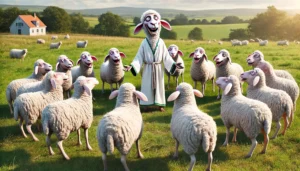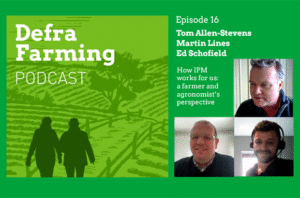
Farmercowboy.com A humorous illustration in the style of Mad Magazine showing cows wearing Fitbits and following a fitness regimen. The cows are running on treadmills.webp.webp
Finishing Cattle for High-Quality Beef: A Educational Guide to Grass-Fed Excellence
Producing high-quality beef is no simple task. It requires a delicate balance of science, art, and humor. From thinking like a grass farmer to understanding the nuances of genetics, every detail matters. Let’s dive into the world of cattle finishing with a satirical twist, highlighting the practices that lead to the best steaks money can buy.
Think Like a Grass Farmer
The Gourmet Grazing Experience
Forget about simple grass – we’re talking high-quality forages that would make a Michelin-star chef jealous. Farmers like Chad and Kim Woods have perfected the art of gourmet grazing. Their cattle dine on a blend of alfalfa, orchardgrass, and novel endophyte tall fescue, with a side of ladino and red clovers. It’s not just about eating; it’s about the dining experience. Picture cows delicately nibbling on these forages, savoring every bite like it’s their last supper.
Pasture Ambiance
Creating the right ambiance is crucial. Pastures are outfitted with decorative lighting and soft jazz music to keep the cows calm and content. It’s all about reducing stress – a happy cow is a tasty cow. For those extra hot days, misters are strategically placed to cool down the cattle, ensuring they remain in peak condition.
Rotational Grazing: The Dance of the Cows
Rotational grazing isn’t just a farming technique; it’s a choreographed dance. Cows are moved from one pasture to another in a seamless ballet, ensuring they always have fresh, nutritious forages. This practice also allows the pastures to recover, providing even better grazing the next time around. Chad Woods explains, “Rotational grazing allows you to utilize forages more effectively and efficiently.”

Supplemental Feed When Needed
The Gourmet Boost
When forages alone aren’t enough, supplemental feeding comes into play. Wet brewers grain is a popular choice, providing the cows with the necessary nutrients to stay healthy and gain weight. It’s like a protein shake, but for cows. Chad Woods emphasizes the importance of this practice: “Brewers grain fits perfectly into our high-quality diet plan.”
Hay Happy Hours
Every evening, the cows gather for “Hay Happy Hour” – the best grass and a social hour to boot. This practice not only keeps the cows well-fed but also strengthens their social bonds, ensuring a harmonious herd.

Age Matters
Tenderness Through Youth
One of the keys to tenderness is the age of the animal. Research shows that cattle less than 20 months old are more tender. Clemson University animal scientist Susan Duckett states, “Younger cattle are generally more tender, but it’s also about how you finish them.”
The Perfect Harvest Age
However, the Woodses find that marketing older animals works better in their program. Chad Woods explains, “We harvest our forage-finished calves at 24-28 months. We have finished some in 20 months, but we weren’t happy with the finish and quality.” This approach ensures that the beef meets the high standards of discerning chefs and consumers.

Genetics Count
The Right Breeds
Selecting the right breed is crucial. For the Woodses, Red Angus and Red Angus-Hereford cattle work well in a forage-finishing program. “We knew red cattle would tolerate the heat better,” Chad said. This is especially important since they still have some Kentucky 31 fescue, which can be challenging in hot weather.
Fine-Tuning Genetics
Genetic selection is fine-tuned to ensure only the best traits are passed on. Chad Woods notes, “We’re also looking at South Poll. They finish well and tolerate heat.” By choosing the right genetics, farmers can ensure their cattle not only survive but thrive in their specific environments.

Educational Observations: The Lighter Side of Cattle Finishing
- Cow Spa Days
- Cows are treated to spa days with mud baths and massages. Relaxed cows produce the best steaks!
- Fitness Regimen
- Cows have their own personal trainers to ensure they get their steps in. Fit cows mean lean beef!
- Gourmet Grazing
- They dine on only the finest forages, like wine and cheese pairings, but for cows. “Today’s menu: Alfalfa with a side of clover.”
- Pasture Music
- Soft jazz is played in the pastures to keep cows calm and stress-free. Nothing like a little Miles Davis to mellow out a cow.
- Clover Couture
- Cows are fitted with stylish clover crowns. Fashionable and delicious!
- Rotational Grazing Choreography
- Moving cows from one pasture to another is like a well-orchestrated dance. Think “Dancing with the Cows.”
- Hay Happy Hours
- Every evening, the cows gather for “Hay Happy Hour” – the best grass and a social hour to boot.
- Sunblock for Bovines
- Cows are slathered with sunblock to protect their tender hides from harsh UV rays. Farmer tans, but for cows.
- Nightly Lullabies
- Farmers sing lullabies to their cows at night to ensure a peaceful sleep. “Twinkle, twinkle, little star…”
- Forage Variety Shows
- The cows are entertained with variety shows to keep them from getting bored. Tonight: “The Grass is Always Greener” skit.
- Grazing GPS
- Cows have GPS collars to optimize their grazing routes. No grass left uneaten!
- Cattle Counseling
- Weekly sessions with a cow psychologist to discuss any grazing anxieties. “How does that make you feel, Bessie?”
- Heatwave Misters
- When it gets too hot, misters cool down the cattle. It’s like a water park for cows.
- Fancy Forage Fencing
- Fences adorned with decorative lights make the pastures feel like five-star resorts. Cows deserve ambiance too.
- Udder Yoga
- Morning yoga sessions to keep the cows limber and happy. Downward-facing cow, anyone?
Conclusion: The Art of High-Quality Beef Production
Producing high-quality beef is an art form. From gourmet forages to high-tech farming practices, every detail matters. So the next time you enjoy a perfectly cooked steak, remember the luxurious lifestyle of the cows that made it possible. And maybe, just maybe, you’ll appreciate the humor in the high-stakes world of cattle farming.
This journey into the satirical world of cattle finishing highlights the blend of serious practices and humorous observations that make high-quality beef production both a science and an art. Whether it’s the careful selection of forages, the importance of genetics, or the amusing aspects of cow spa days and fitness regimens, every element contributes to the ultimate goal: delicious, tender beef.
Disclaimer: A Collaborative Creation
This article is the result of a completely human collaboration between a cowboy and a farmer. Any resemblance to actual farming practices is purely coincidental, though we suspect some cows might enjoy a good spa day.
Originally Published at FarmerCowboy.com
2024-07-23 11:09:56
Karl Hoffman is a distinguished agriculturalist with over four decades of experience in sustainable farming practices. He holds a Ph.D. in Agronomy from Cornell University and has made significant contributions as a professor at Iowa State University. Hoffman’s groundbreaking research on integrated pest management and soil health has revolutionized modern agriculture. As a respected farm journalist, his column “Field Notes with Karl Hoffman” and his blog “The Modern Farmer” provide insightful, practical advice to a global audience. Hoffman’s work with the USDA and the United Nations FAO has enhanced food security worldwide. His awards include the USDA’s Distinguished Service Award and the World Food Prize, reflecting his profound impact on agriculture and sustainability.





The internet makes it possible to expand your knowledge on your own terms. ??